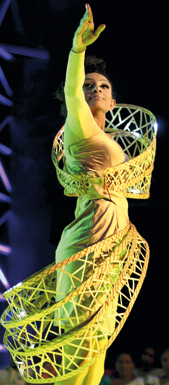Uplifting crafts and communities
Sri Lanka has nurtured numerous arts and crafts that are deeply rooted in history and culture. This includes the bamboo industry, although production at a commercial level only began in the 1970s. The second year students of the Department of Integrated Design at the Faculty of Architecture of the University of Moratuwa in collaboration with the Sri Lanka Institute of Marketing, under their project ‘Gamata Marketing’ unveiled their annual exhibition of local crafts ‘UNA 2013’, this year on the theme of bamboo. It was followed by an exciting avant-garde fashion show of bamboo on Saturday, August 10 at the Park Street Mews.

Pix by M.A. Pushpa Kumara
Every year, the students following this degree programme produce a conceptualised designer collection, taking up a local industry and building on it to uplift the craft and incorporate new trends to help the rural communities. Last year, they chose the cane industry and this year bamboo. Through this project they hope to support bamboo production in two villages: Kuruwita, which was one of the first bamboo design centres established and Yatiyanthota which is a freshly established centre for bamboo craft.
With changing trends, the demand for bamboo products has seen a drastic drop and this was one of the reasons the students thought of using bamboo as their theme for this year’s exhibition. The exhibition showcased the work of 51 students who collaborated with 16 skilled craftsmen and women in the villages.
From the hollowness of the bamboo, to its shape, size, strength and colour, many of its features were seen to have influenced these creative minds. The exhibition had light fixtures of different shapes and sizes, all using bamboo in its natural state without the addition of colour or polish. There were light fittings that could be fixed to walls, tables and also chandeliers of different heights and volume.
“What influenced my design, ‘The gateway to bliss’ were the patterns seen in the cross section and the flexibility of the tree. For me it was a fantasy because it’s a form of putting my imagination into a product. I enjoyed every bit of the work,” said student Amani Weerasinghe.
“I think there’s a great future for this craft. I found my influence in the basic form of the bamboo tree,” said another student Mindula Mahaarachchi. “That’s why I thought of naming my concept ‘Bambush’. I aimed my product at the upper middle class household. My aim was to produce something for those who were afraid of sleeping in the dark. The cover of my product gives only a dull background light which won’t disturb a person’s sleep.”
According to Mindula, the biggest challenge faced by bamboo craftsmen is the lack of technology. The new generation has lost interest and this poses a threat to the future of the bamboo industry.
The event was also visited by many potential customers who showed an interest in the field as well as new architectural trends. The director of designs and marketing of Kandygs Handlooms (Exports) Ltd., Anuradha Yahampath found much to her satisfaction.
“This show was fantastic. It was novel and very creative. There’s a huge potential for these students as well as this industry. The reason why I came to watch this was because we are also working with bamboo. We are currently experimenting with bamboo textiles. Believe it or not the saree I’m wearing is a hundred percent bamboo. The success of this show is obvious, but it’ll be long lasting if they help the crafters to establish these new products by showing them a market. I wish these students all the best,” Ms. Yahampath said.
The fashion show that evening, featured creations all done by the students themselves made completely out of bamboo. The designs represented elements of nature. From dawn to dusk, fire, air, earth, water, the moon and even the stars as well as flowers, birds, trees and even a bamboo bush were depicted with finesse giving extreme attention to smaller details. The show was choreographed by veteran artiste Ravibandu Vidyapathi and a musical item was presented by his students who performed beautifully using traditional percussion instruments as well as bamboo instruments.
The event came to an end with the students felicitating the crafters. The project website ‘Gamata Marketing’ – www.slimgamatamarketing.com was also launched.
comments powered by Disqus

